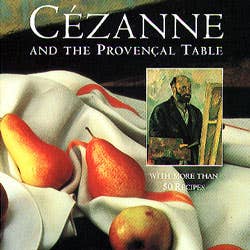
Paul Cooks (or Not)
In the late 1980s, a descendant of Impressionist master Claude Monet decided to publish some family recipes. She pored through the artist's notebooks and tested the recipes in his kitchen at Giverny, enlisting the help of three-star Parisian chef Joel Robuchon. Photographer Jean-Bernard Naudin supplied gorgeously moody photographs of Monet's house, the landscape around it, and the food itself. Packaged with a touching biography of the artist and many family photographs, Monet's Table (Simon & Schuster, 1989) contributes to our understanding of the artist's work and offers new insight into his life. It has also been a huge success.
The formula was so inspired that it has since been repeated—with, for instance, Dining with Toulouse-Lautrec (Random House, 1993), Renoir's Table (Simon & Schuster, 1994), and Cezanne and the Provençal Table (Clarkson Potter, 1995) —all with photographs by Naudin, and, in the case of the Cezanne volume, with a preface by noted chef Alain Ducasse, a foreword by Philippe Cezanne (a "descendant" of the artist; the exact relationship is never spelled out more clearly than that), text by Cezanne scholar Gilles Plazy, and "authentic Provençal recipes" by food editor Jacqueline Saulnier.
Unfortunately, each successive volume in this loosely linked series has strayed farther from its source and has proven less satisfying than the one before it. In the present case, the authors have done their best to capitalize on the craze for Provence (and Impressionism), but they have had a very hard time indeed turning Cezanne—a frugal, difficult man—into a fit subject for a cookbook.
Cezanne was a solitary soul. He did not have much of a family life. Although he married his mistress to give his wealthy father a legitimate grandson, he was never more than a visitor to his wife and child. (They lived in Paris, while he stayed in Provence.) He once called his parents "the most annoying people in the world."
Philippe Cezanne admits that his first reaction to the idea of a book linking his ancestor with cuisine was "one of disbelief." That's not surprising: Cezanne was no cook. Food apparently meant little to him. He struggled with diabetes, and had to watch his diet. When asked what his favorite food was, he answered, "Potatoes in oil".
Still, Plazy has done his best to find a food connection, apparently repeating every word he could dig up that Cezanne ever uttered on the subject. Thus, we have things like the artist explaining to a childhood friend, Henri Gasquet, that the fruits in his still lives "… like to have their portrait painted, it's as if they're asking forgiveness for fading …". In his conclusion, Plazy adds, "[T]he fact that he returned to nude figures and food toward the end of his life shows how important they were to him …". This is a pretty thin premise for a cookbook.
The book isn't much of a biography, either. Plazy offers such a disjointed portrait of the artist that even the chronology is hard to follow. At what point was Cezanne diagnosed with diabetes? How old was the artist's son when his father married his mother? It is impossible to tell from Plazy's text.
Then there are the recipes—a mere 51 of them. These are pleasant enough, but they tend to leave things out. The recipe for petits pates chauds, for instance, begins by calling for "1 1⁄4 pounds savory pastry"—but the pastry recipe is not provided. The real problem, however, is that there is no apparent connection between Saulnier's recipes and the artist to whom they supposedly relate. Why have these particular recipes been chosen? Simply because they're Provençal, and Cezanne lived and painted in Provence? The authors haven't even had the wit to include a recipe for "potatoes in oil".
But the pictures are gorgeous. Perhaps it is time for Naudin to expand his scope beyond the small circle of late 19th-century male French artists he has thus far taken as his subject. I have a suggestion: In 1991, Red Crane Books in Santa Fe, New Mexico, published A Painter's Kitchen: Recipes from the Kitchen of Georgia O'Keeffe in a modest edition. O'Keeffe was a determined gardener and a talented cook with decided ideas on the subject of food. Imagine what an inspired book her life and recipes could make in the hands of a great photographer!
Keep Reading
Continue to Next Story










